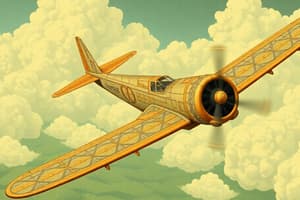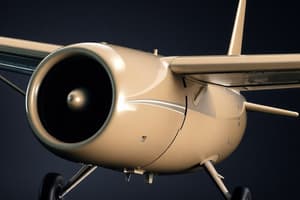Podcast
Questions and Answers
What was a key technological advancement that distinguished the Junkers all-metal monoplane from earlier aircraft designs during World War I?
What was a key technological advancement that distinguished the Junkers all-metal monoplane from earlier aircraft designs during World War I?
- The adoption of an all-metal stressed skin construction. (correct)
- The pioneering manual flight control systems.
- The implementation of complex biplane structures for enhanced lift.
- The exclusive use of wood in its frame.
Considering the evolution of flight from the Wright Flyer to the A380, which statement accurately reflects a significant advancement in aviation technology?
Considering the evolution of flight from the Wright Flyer to the A380, which statement accurately reflects a significant advancement in aviation technology?
- The number of passengers that can be carried decreased over time.
- The range and speed capabilities show a substantial increase, reflecting improvements in engine technology and aerodynamics. (correct)
- A shift towards simpler designs has improved maneuverability.
- A reduction in aircraft weight is observed, enhancing fuel efficiency.
In the context of aircraft design, what primary aerodynamic benefit is achieved by utilizing streamlined shapes, as opposed to blunt shapes?
In the context of aircraft design, what primary aerodynamic benefit is achieved by utilizing streamlined shapes, as opposed to blunt shapes?
- Higher pressure on the front surface.
- Reduced flow separation and a lower drag coefficient. (correct)
- Increased drag coefficient.
- Enhanced turbulence behind the object.
What is the primary function of vortex generators on an aircraft wing?
What is the primary function of vortex generators on an aircraft wing?
During high-speed flight approaching or exceeding the speed of sound, what aerodynamic phenomenon becomes a primary concern for aircraft designers?
During high-speed flight approaching or exceeding the speed of sound, what aerodynamic phenomenon becomes a primary concern for aircraft designers?
What purpose does a Pitot-static tube serve on an aircraft?
What purpose does a Pitot-static tube serve on an aircraft?
What distinguishes aerostatics from aerodynamics?
What distinguishes aerostatics from aerodynamics?
What is the significance of achieving an elliptic lift distribution across an aircraft's wing?
What is the significance of achieving an elliptic lift distribution across an aircraft's wing?
How did the introduction of all-metal monoplanes, like the Junkers, impact aviation during and after World War I?
How did the introduction of all-metal monoplanes, like the Junkers, impact aviation during and after World War I?
What is the effect of 'Flow Separation' on an aircraft wing and why is it detrimental to flight?
What is the effect of 'Flow Separation' on an aircraft wing and why is it detrimental to flight?
Flashcards
Atmospheric Flight Mechanics
Atmospheric Flight Mechanics
The science and engineering of flight within the Earth's atmosphere.
Lighter-than-air vehicles
Lighter-than-air vehicles
Vehicles that stay aloft because they are filled with a gas that is lighter than air.
Aerodynamics
Aerodynamics
The study of forces and the resulting motion of objects through the air.
Aerostatics
Aerostatics
Signup and view all the flashcards
Atmosphere
Atmosphere
Signup and view all the flashcards
Jet Stream
Jet Stream
Signup and view all the flashcards
Flow Separation
Flow Separation
Signup and view all the flashcards
Streamlined Shapes
Streamlined Shapes
Signup and view all the flashcards
High Lift Devices
High Lift Devices
Signup and view all the flashcards
Shock Waves
Shock Waves
Signup and view all the flashcards
Study Notes
- Atmospheric Flight Mechanics is worth [3-0-0] credits
Course Overview
- Introduction to the atmosphere
- Anatomy of an aircraft
- Basics of aerodynamics and propulsion
- Introduction to aircraft stability and control
- Equations of motion in relation to aircraft performance
General Aviation History
- Montgolfier designed lighter-than-air vehicles around 1783
- Sir George Caley created a fixed-wing modern aircraft configuration in 1843
- Otto Lileinthal designed and flew a glider in 1885
- The Wright brothers achieved powered flight in 1903
- The Wright flyer in 1903 had a top speed of 48 km/h, range of 260 km, and weight of 274 kg
- The Airbus A380 was introduced in 2005
- The Airbus A380 has a top speed of 1,020 km/h, range of 15,700 km, and weight of 590,000 kg
Aviation in Wartime
- Airplanes played an important role in the World Wars
- Aircraft like the Spitfire, Consolidated PBY, B-17 Flying Fortress, Douglas DC3, and Horsa Glider were used in WW2 (1939-45)
- Jet aircraft like the Me 262 and Arado Ar34 were important in WW2 (1939-45)
Commercial Aviation
- The DC3 was in use by 1958
- The DeHavilland Comet followed in 1952
Aircraft Engineering
- The realm of Aerospace Engineering is split into aeronautics
- Aircraft, UAV/MAV, and Rockets are all examples of aeronautics in action
Aerodynamics
- Aerostatics deals with buoyancy
- Dynamics deal with higher forces
- Streamlined shapes have a drag coefficient of CD = 0.05
- Blunt shapes have a drag coefficient of CD = 1- 0.6
Airfoil function
- Air flows faster over the upper surface
- Air flows lower over the lower surface
Atmospheric Layers
- It consists of layers like the troposphere, stratosphere, mesosphere, and thermosphere
- The temperatures and gradients are different depending on the layer
- Jet streams are air currents that flow around the earth
Atmospheric Measurement
- Static ports help measure altitude
- Pitot tubes measure velocity
- An angle of attack sensor measures relative angle to the wind
Studying That Suits You
Use AI to generate personalized quizzes and flashcards to suit your learning preferences.
Related Documents
Description
Explore atmospheric flight mechanics, covering aircraft anatomy, aerodynamics, and stability. Review the history of aviation from early designs to modern aircraft like the Airbus A380. Examine the role of airplanes in wartime, highlighting key aircraft used in the World Wars.




